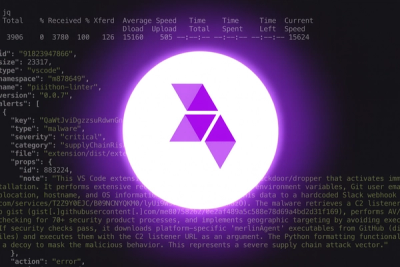
Product
Introducing Webhook Events for Alert Changes
Add real-time Socket webhook events to your workflows to automatically receive software supply chain alert changes in real time.
This repository contains JavaScript based examples of many popular algorithms and data structures.
Each algorithm and data structure has its own separate README with related explanations and links for further reading (including ones to YouTube videos).
Read this in other languages: 简体中文, 繁體中文, 한국어, 日本語, Polski, Français, Español, Português
☝ Note that this project is meant to be used for learning and researching purposes only and it is not meant to be used for production.
A data structure is a particular way of organizing and storing data in a computer so that it can be accessed and modified efficiently. More precisely, a data structure is a collection of data values, the relationships among them, and the functions or operations that can be applied to the data.
B - Beginner, A - Advanced
B Linked ListB Doubly Linked ListB QueueB StackB Hash TableB Heap - max and min heap versionsB Priority QueueA TrieA Tree
A Binary Search TreeA AVL TreeA Red-Black TreeA Segment Tree - with min/max/sum range queries examplesA Fenwick Tree (Binary Indexed Tree)A Graph (both directed and undirected)A Disjoint SetA Bloom FilterAn algorithm is an unambiguous specification of how to solve a class of problems. It is a set of rules that precisely define a sequence of operations.
B - Beginner, A - Advanced
B Bit Manipulation - set/get/update/clear bits, multiplication/division by two, make negative etc.B FactorialB Fibonacci Number - classic and closed-form versionsB Primality Test (trial division method)B Euclidean Algorithm - calculate the Greatest Common Divisor (GCD)B Least Common Multiple (LCM)B Sieve of Eratosthenes - finding all prime numbers up to any given limitB Is Power of Two - check if the number is power of two (naive and bitwise algorithms)B Pascal's TriangleB Complex Number - complex numbers and basic operations with themB Radian & Degree - radians to degree and backwards conversionB Fast PoweringA Integer PartitionA Square Root - Newton's methodA Liu Hui π Algorithm - approximate π calculations based on N-gonsA Discrete Fourier Transform - decompose a function of time (a signal) into the frequencies that make it upB Cartesian Product - product of multiple setsB Fisher–Yates Shuffle - random permutation of a finite sequenceA Power Set - all subsets of a set (bitwise and backtracking solutions)A Permutations (with and without repetitions)A Combinations (with and without repetitions)A Longest Common Subsequence (LCS)A Longest Increasing SubsequenceA Shortest Common Supersequence (SCS)A Knapsack Problem - "0/1" and "Unbound" onesA Maximum Subarray - "Brute Force" and "Dynamic Programming" (Kadane's) versionsA Combination Sum - find all combinations that form specific sumB Hamming Distance - number of positions at which the symbols are differentA Levenshtein Distance - minimum edit distance between two sequencesA Knuth–Morris–Pratt Algorithm (KMP Algorithm) - substring search (pattern matching)A Z Algorithm - substring search (pattern matching)A Rabin Karp Algorithm - substring searchA Longest Common SubstringA Regular Expression MatchingB Linear SearchB Jump Search (or Block Search) - search in sorted arrayB Binary Search - search in sorted arrayB Interpolation Search - search in uniformly distributed sorted arrayB Bubble SortB Selection SortB Insertion SortB Heap SortB Merge SortB Quicksort - in-place and non-in-place implementationsB ShellsortB Counting SortB Radix SortB Depth-First Search (DFS)B Breadth-First Search (BFS)B Depth-First Search (DFS)B Breadth-First Search (BFS)B Kruskal’s Algorithm - finding Minimum Spanning Tree (MST) for weighted undirected graphA Dijkstra Algorithm - finding shortest paths to all graph vertices from single vertexA Bellman-Ford Algorithm - finding shortest paths to all graph vertices from single vertexA Floyd-Warshall Algorithm - find shortest paths between all pairs of verticesA Detect Cycle - for both directed and undirected graphs (DFS and Disjoint Set based versions)A Prim’s Algorithm - finding Minimum Spanning Tree (MST) for weighted undirected graphA Topological Sorting - DFS methodA Articulation Points - Tarjan's algorithm (DFS based)A Bridges - DFS based algorithmA Eulerian Path and Eulerian Circuit - Fleury's algorithm - Visit every edge exactly onceA Hamiltonian Cycle - Visit every vertex exactly onceA Strongly Connected Components - Kosaraju's algorithmA Travelling Salesman Problem - shortest possible route that visits each city and returns to the origin cityB Polynomial Hash - rolling hash function based on polynomialB NanoNeuron - 7 simple JS functions that illustrate how machines can actually learn (forward/backward propagation)B Tower of HanoiB Square Matrix Rotation - in-place algorithmB Jump Game - backtracking, dynamic programming (top-down + bottom-up) and greedy examplesB Unique Paths - backtracking, dynamic programming and Pascal's Triangle based examplesB Rain Terraces - trapping rain water problem (dynamic programming and brute force versions)B Recursive Staircase - count the number of ways to reach to the top (4 solutions)A N-Queens ProblemA Knight's TourAn algorithmic paradigm is a generic method or approach which underlies the design of a class of algorithms. It is an abstraction higher than the notion of an algorithm, just as an algorithm is an abstraction higher than a computer program.
B Linear SearchB Rain Terraces - trapping rain water problemB Recursive Staircase - count the number of ways to reach to the topA Maximum SubarrayA Travelling Salesman Problem - shortest possible route that visits each city and returns to the origin cityA Discrete Fourier Transform - decompose a function of time (a signal) into the frequencies that make it upB Jump GameA Unbound Knapsack ProblemA Dijkstra Algorithm - finding shortest path to all graph verticesA Prim’s Algorithm - finding Minimum Spanning Tree (MST) for weighted undirected graphA Kruskal’s Algorithm - finding Minimum Spanning Tree (MST) for weighted undirected graphB Binary SearchB Tower of HanoiB Pascal's TriangleB Euclidean Algorithm - calculate the Greatest Common Divisor (GCD)B Merge SortB QuicksortB Tree Depth-First Search (DFS)B Graph Depth-First Search (DFS)B Jump GameB Fast PoweringA Permutations (with and without repetitions)A Combinations (with and without repetitions)B Fibonacci NumberB Jump GameB Unique PathsB Rain Terraces - trapping rain water problemB Recursive Staircase - count the number of ways to reach to the topA Levenshtein Distance - minimum edit distance between two sequencesA Longest Common Subsequence (LCS)A Longest Common SubstringA Longest Increasing SubsequenceA Shortest Common SupersequenceA 0/1 Knapsack ProblemA Integer PartitionA Maximum SubarrayA Bellman-Ford Algorithm - finding shortest path to all graph verticesA Floyd-Warshall Algorithm - find shortest paths between all pairs of verticesA Regular Expression MatchingB Jump GameB Unique PathsB Power Set - all subsets of a setA Hamiltonian Cycle - Visit every vertex exactly onceA N-Queens ProblemA Knight's TourA Combination Sum - find all combinations that form specific sumInstall all dependencies
npm install
Run ESLint
You may want to run it to check code quality.
npm run lint
Run all tests
npm test
Run tests by name
npm test -- 'LinkedList'
Playground
You may play with data-structures and algorithms in ./src/playground/playground.js file and write
tests for it in ./src/playground/__test__/playground.test.js.
Then just simply run the following command to test if your playground code works as expected:
npm test -- 'playground'
▶ Data Structures and Algorithms on YouTube
Big O notation is used to classify algorithms according to how their running time or space requirements grow as the input size grows. On the chart below you may find most common orders of growth of algorithms specified in Big O notation.

Source: Big O Cheat Sheet.
Below is the list of some of the most used Big O notations and their performance comparisons against different sizes of the input data.
| Big O Notation | Computations for 10 elements | Computations for 100 elements | Computations for 1000 elements |
|---|---|---|---|
| O(1) | 1 | 1 | 1 |
| O(log N) | 3 | 6 | 9 |
| O(N) | 10 | 100 | 1000 |
| O(N log N) | 30 | 600 | 9000 |
| O(N^2) | 100 | 10000 | 1000000 |
| O(2^N) | 1024 | 1.26e+29 | 1.07e+301 |
| O(N!) | 3628800 | 9.3e+157 | 4.02e+2567 |
| Data Structure | Access | Search | Insertion | Deletion | Comments |
|---|---|---|---|---|---|
| Array | 1 | n | n | n | |
| Stack | n | n | 1 | 1 | |
| Queue | n | n | 1 | 1 | |
| Linked List | n | n | 1 | n | |
| Hash Table | - | n | n | n | In case of perfect hash function costs would be O(1) |
| Binary Search Tree | n | n | n | n | In case of balanced tree costs would be O(log(n)) |
| B-Tree | log(n) | log(n) | log(n) | log(n) | |
| Red-Black Tree | log(n) | log(n) | log(n) | log(n) | |
| AVL Tree | log(n) | log(n) | log(n) | log(n) | |
| Bloom Filter | - | 1 | 1 | - | False positives are possible while searching |
| Name | Best | Average | Worst | Memory | Stable | Comments |
|---|---|---|---|---|---|---|
| Bubble sort | n | n2 | n2 | 1 | Yes | |
| Insertion sort | n | n2 | n2 | 1 | Yes | |
| Selection sort | n2 | n2 | n2 | 1 | No | |
| Heap sort | n log(n) | n log(n) | n log(n) | 1 | No | |
| Merge sort | n log(n) | n log(n) | n log(n) | n | Yes | |
| Quick sort | n log(n) | n log(n) | n2 | log(n) | No | Quicksort is usually done in-place with O(log(n)) stack space |
| Shell sort | n log(n) | depends on gap sequence | n (log(n))2 | 1 | No | |
| Counting sort | n + r | n + r | n + r | n + r | Yes | r - biggest number in array |
| Radix sort | n * k | n * k | n * k | n + k | Yes | k - length of longest key |
FAQs
test lib
We found that easy-algo demonstrated a not healthy version release cadence and project activity because the last version was released a year ago. It has 1 open source maintainer collaborating on the project.
Did you know?

Socket for GitHub automatically highlights issues in each pull request and monitors the health of all your open source dependencies. Discover the contents of your packages and block harmful activity before you install or update your dependencies.

Product
Add real-time Socket webhook events to your workflows to automatically receive software supply chain alert changes in real time.

Security News
ENISA has become a CVE Program Root, giving the EU a central authority for coordinating vulnerability reporting, disclosure, and cross-border response.

Product
Socket now scans OpenVSX extensions, giving teams early detection of risky behaviors, hidden capabilities, and supply chain threats in developer tools.